For the critic, commentator or scholar of Brown’s works, speculation even if informed, should be engaged in carefully. At one point an editor in a slip of the tongue announced that Brown’s next novel would be entitled: The Solomon Key. The novel that eventually appeared was The Lost Symbol, but not before a guide to The Solomon Key appeared.
Brown did a BBC interview shortly after the publication of Origin. It contains few spoilers, but might urge you to read the novel.
More spoilers came in a CBS interview two months after the novel appeared with a Brown interview on CBS Morning.
Brown has once again steered his reader to a new setting in a video that highlights Bilboa, Madrid, Seville and Barcelona.
Many of the dust covers for foreign editions highlight the city of Barcelona with special emphasis on the Sagrada Familia Cathedral and the image of the spiral. See the notes on these covers.
There are also on Facebook and Twitter recurring indications of the prominent places that the publication announcement has highlighted, namely Bilbao and Barcelona.
“Bilbao, Spain
Robert Langdon, Harvard professor of symbology and religious iconology, arrives at the ultramodern Guggenheim Museum Bilbao to attend a major announcement—the unveiling of a discovery that “will change the face of science forever.”
The Guggenheim Museum in Barcelona is one of the several photos contained on Brown’s Facebook page.
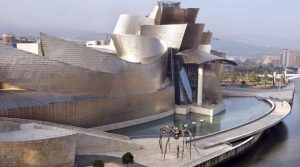
“the meticulously orchestrated evening suddenly erupts into chaos, . . . Reeling and facing an imminent threat, Langdon is forced into a desperate bid to escape Bilbao. With him is Ambra Vidal, the elegant museum director who worked with Kirsch to stage the provocative event. Together they flee to Barcelona on a perilous quest to locate a cryptic password that will unlock Kirsch’s secret.”
Barcelona figures prominently on the covers of many of the world wide editions. The view is invariably directed at the landmark of the Sagrada Familia Cathedral. The Cathedral in turn points to the architecture of the renown Antoni Gaudi.
But there are other Facebook photos that reference:
1). A spiral staircase. This is actually the Cotton House Hotel in Barcelona.

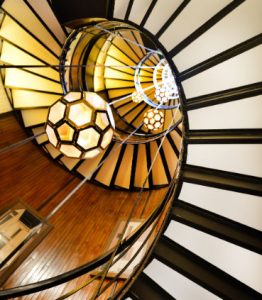
2. The Casa Mila, one of Gaudi’s creations.
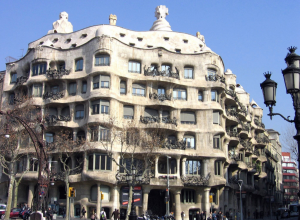
3) The Passeig de Gracia, the street on which the Casa is located. “One thing that many people do not know, however, is that the pavement tiles with sea life patterns on the sidewalks of Passeig de Gràcia were designed by Gaudí.” The role of Gaudi is unquestioned, but two aspects of his life or death are worth noting: his interest in the esoteric or hermetic tradition, and the mysterious circumstances surrounding his tragic death,
Brown has a replica of these tiles in his home, along with the Picasso sketch, Head of a Woman in the series War and Peace based on Leo Tolstoi’s novel.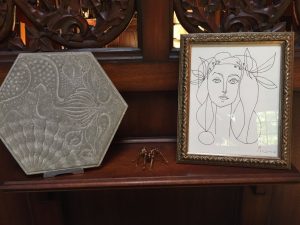
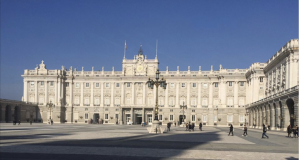
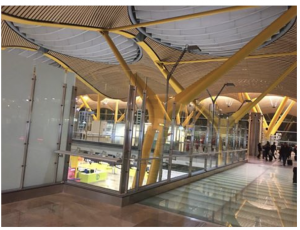
Madrid is also likely to place of interest with a photo of the Royal Palace and another of the Adolfo Suárez Madrid–Barajas Airport on Brown’s Facebook page just one week before the publication of the novel.
Modesty for Brown scholars is an absolute necessity. Frequently as noted he has misled would-be authors of books about his books. My original best guess in October 2016 was that Amsterdam would figure prominently in the novel.
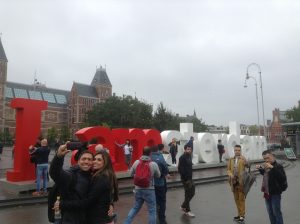
In December 2016 Brown posted to his Facebook page a panorama photo taken in Amsterdam’s Rijksmuseum.

The painting on the left is Rembrandt’s The Night Watch.

In addition to the Rijksmuseum, Amsterdam is the home of the Van Gogh Museum and Brown used a Facebook post to highlight that artist.
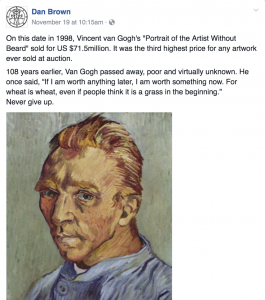
Amsterdam re-appears with the announcement that Dan Brown’s book tour will take him to Amsterdam on October 22 at the John Adams House, West-Indisch Huis, Herenmarkt 97 , 1013 EC Amsterdam.
In late January of 2016 Dan tweeted and placed a photo on Facebook of the Basement in the Prague Castle.
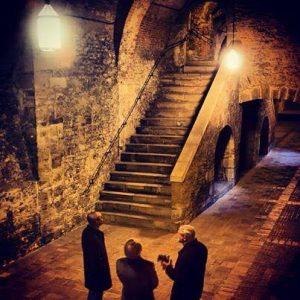
Another collection with rare manuscripts is the Morgan Museum and Library in New York City, recently featured on Dan Brown’s Facebook page among his Monday Masterpieces.
On April 2, 2017 on the dedicated Facebook page for Origin, Brown published a photo of a painting asking for an identification. It was quickly identified as Colossus by Francisco de Goya.
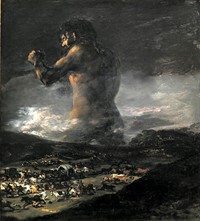
But here too is a mystery as noted by Brendy Merk “The Colossus (1818 -1825), Oil on Canvas,116 x105cm. Attributed to Francisco de Goya until 2008, new art historical and technical studies led to a reconsideration of the painting’s attribution, particularly following the tentative reading of the marks in the lower left corner as the initials”A.J.” They may refer to Asensio Julia (1760 – 1832), a friend and occasional collaborator of Goya. The meaning of the painting remains unclear. For some, this terrifying giant towering over the horizon is the symbol of war which drives men and animals to flee, the incarnation of Napoleon himself. For others, it is not that but rather the guardian spirit of Spain against the invader, or rather the people becoming conscious of its own power.”
Another Facebook post in April 2017 pointed to the Barcelona artist Joan Miro’s “Hirondelle Amour” that is actually at the New York Museum of Modern Art.
In May 2017 a photo of the Cathedral of Our Lady in Antwerp appeared on Brown’s Facebook page. Hints abound before a novel is actually released, but Antwerp and Amsterdam, the history of the Netherlands are intertwined.
A mysterious calligraphy cover emerges with the word Origin. But does it contain a deeper meaning?
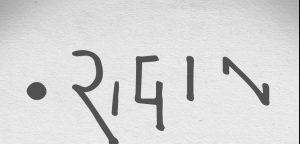
You must be logged in to post a comment.